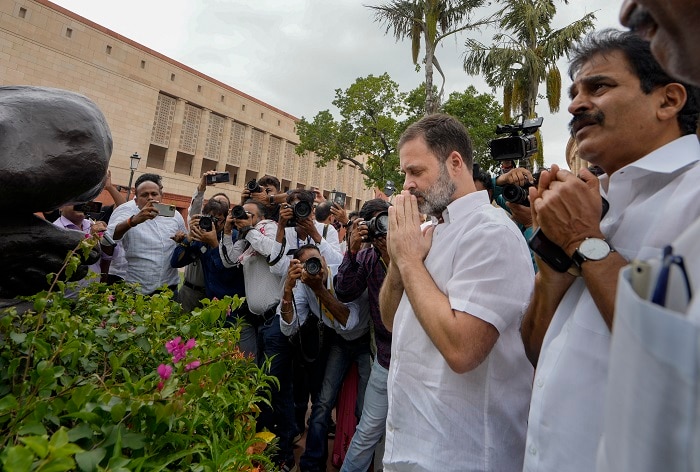Home News India No-Confidence Motion In Lok Sabha As Govt Faces The Heat Over Manipur Unrest, Rahul Gandhi To Open Debate; What All To Expect
The Lok Sabha will take up the discussion on a no-confidence motion on Tuesday. This session is anticipated to last for 12 hours. Congress MP Rahul Gandhi, who returned to Parliament on Monday after four months, is likely to open the discussion in Lok Sabha on Tuesday.
New Delhi: Congress MP Rahul Gandhi pays tribute to Mahatma Gandhi at Parliament House complex during Monsoon Session, in New Delhi, Monday, Aug. 7, 2023. The Lok Sabha membership of Rahul Gandhi was restored on Monday, days after the Supreme Court stayed his conviction in a defamation case. (PTI Photo/Vijay Verma)
New Delhi: The much-awaited debate on the no-confidence motion is to be held in Lok Sabha on Tuesday and Wednesday, August 8 and 9, before being put to a vote. The no-confidence motion, which was moved by the Congress and supported by the newly formed opposition bloc INDIA, was accepted by Lok Sabha Speaker Om Birla last week. Though the motion has been moved by Congress’ Gaurav Gogoi, the leader of the party in the LS Adhir Ranjan Chowdhury said that Rahul Gandhi will “in all likelihood” be the first speaker when the House takes up the issue at noon.
“We have been allotted 90 minutes to make our points during the motion. There’s a likelihood that Rahul Gandhi will be our first speaker,” Chowdhury said. In all, the Congress is likely to field 7-8 speakers, and apart from Gandhi, Gogoi and Chowdhury are going to speak. Prime Minister Narendra Modi is expected to reply to the discussion on the motion on August 10. The agenda of business for August 9 and 10, however, is yet to be announced officially.
According to reports, some of the key speakers that will take part in the no-trust motion are going to be from eastern India, to address the debates on the Manipur violence as well as to raise the issue of violence in West Bengal. Congress’s deputy floor leader Gaurav Gogoi had filed the notice for a no-confidence motion on July 26, which was later accepted by the Speaker. The Business Advisory Committee (BAC) of the Lok Sabha in a meeting on Monday allotted 12 hours for the discussion.
This is the second no-confidence motion that the Modi government is facing. In July 2018, the government defeated a motion by 199 votes. The debate, which went on for 12 hours, saw (then) Congress president Rahul Gandhi walk across the well to hug PM Modi.
Though the opposition knows there’s hardly any chance of winning the no-confidence vote. But the party leaders argue that the motion means the prime minister will have to appear on the Parliament floor to answer questions and address the Manipur crisis. The proponents of the motion are betting that just bringing it up will force Prime Minister Narendra Modi to address the Manipur crisis from the floor of Parliament. The newly formed INDIA alliance comprising 26 opposition parties have been pushing for a statement from Modi on Manipur in Parliament since its session began last month. More than 150 people have died and over 50,000 displaced after ethnic clashes in Manipur erupted in early May.
What’s a No-Confidence Motion?
In a democracy like India, a government can be in power only if it can prove its majority in the directly elected House of the parliament, Lok Sabha. The No-Confidence Motion is the mechanism to test the government’s majority as prescribed by the Constitution. The Article 75(3) of the Constitution says the Council of Ministers is collectively responsible to the Lok Sabha.
To test the collective responsibility of the MPs, the Lok Sabha allows the Motion of No-confidence, which is also called the Vote of No Confidence. Any lower house MP, who has the support of 50 colleagues, can, at any point of time, introduce the motion of no-confidence against the Council of Ministers. Once a ‘no-confidence’ motion is moved in the Lok Sabha, and the Speaker is of the opinion that the motion is proper, then s/he reads out the motion to the house. A minimum of 50 members have to accept the motion. If not, then the motion fails and is not admitted for discussion. A vote takes place at the end of the debate among Lok Sabha members on the motion. If the motion passes, the government has to vacate office. On the other hand, the prime minister can also move a ‘confidence’ motion in order to prove the strength of the government in the Lok Sabha. A No-Confidence Motion can only be moved in the Lok Sabha.
Don’t Miss Out on the Latest Updates. Subscribe to Our Newsletter Today! Subscribe Now

